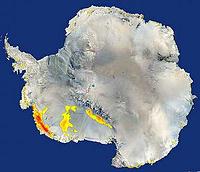 倘若專家預測無誤,南極西部的冰層因全球暖化而溶解或崩塌, 最近這份研究指出,海平面上升幅度對美國許多地區的影響將「顯著超出」目前所模擬的狀況。
倘若專家預測無誤,南極西部的冰層因全球暖化而溶解或崩塌, 最近這份研究指出,海平面上升幅度對美國許多地區的影響將「顯著超出」目前所模擬的狀況。
科學家表示,全世界海平面上升幅度恐怕比預期更更嚴重,例如目前預測值為全球平均上升16、17英呎,但在華府地區,恐怕將增加到21英呎,屆時大半華府將會泡在水裡,東南沿海岸和佛羅里達南部將消失在浪花中。
這份研究報告是奧瑞岡州立大學和多倫多大學的研究人員合作完成,發表在2月6日出刊的《科學》雜誌,標題是〈南極西部冰層崩解的海平面指紋〉。
奧瑞岡州大的地球科學教授克拉克(Peter Clark)表示:「這份報告並不是宣告南極冰層即將崩解,只是大部分的冰層邊緣已經融出成為漂浮的冰棚,包括最大的羅斯冰棚(Ross Ice Shelf)和龍尼冰棚(Ronne Ice Shelf),這個現象不啻顯明潛在的不穩定性。」
這個顧慮正好呼應華盛頓大學教授史塔(Eric Steig)最近的研究,他指出南極西部的冰層的確在暖化當中。
早在2005年,太空總署和大學合作的團隊已經發現明顯證據,顯示南極西部有很大面積的雪在融化,這是過去30年間衛星觀測到最顯著的一次融雪。
克拉克解釋:「目前仍不清楚,南極西部的冰層是否確實會崩解、或者何時會發生;可能在接下來數百年都不會發生,也可能不會完全崩毀,相關研究應持續進行,追蹤冰層狀態。」
聯合國跨政府氣候變遷小組(IPCC)預測,南極西部冰層崩毀會使海平面平均上升16.5英呎,這個數值目前仍被廣泛引用;但克拉克和他的團隊認為,這個預測值過於理論,並沒有考慮實際情況中的幾個關鍵因素,例如重力、地球自轉的差異、和冰河覆蓋的陸地因壓力所造成的反作用力。
目前,南極西部的冰層在廣大的南極大陸上仍有超過6000英呎高度的巨大冰塊,形成一種吸引海水的重力,研究人員解釋,就像太陽和月亮在地球上造成的重力,牽引潮起潮落,冰層也會對產生一種吸力。
 這份研究在計算海平面上又加入其他考量因子,包括冰層對陸地的壓力所造成的反作用力,和對地球自轉軸的影響。當冰層漸漸融解,陸地本身會因反作用力而升高;地球自轉軸會隨而移動1/3英哩,進而影響海平面在不同地區的上升幅度。
這份研究在計算海平面上又加入其他考量因子,包括冰層對陸地的壓力所造成的反作用力,和對地球自轉軸的影響。當冰層漸漸融解,陸地本身會因反作用力而升高;地球自轉軸會隨而移動1/3英哩,進而影響海平面在不同地區的上升幅度。
考慮這些變因後,這份報告的結論是,接近南極的海平面會下降,而北半球的海平面會上升。
如果南極西部的冰層完全融解,北美東岸海平面將會上升21呎--比原先估計的更高4呎,西海岸和邁阿密將面臨上升22呎的海面。
歐洲大部分海平面約上升18英呎,印度洋南方的國家也會面臨沿岸地區淹沒的危機。
If global warming ever causes the West Antarctic Ice Sheet to collapse, as many experts believe it could, the resulting sea level rise in much of the United States would be "significantly higher" than is currently projected, a new study concludes.
The catastrophic increase in sea level, already projected to average between 16 and 17 feet around the world, would be almost 21 feet in such places as Washington, DC, scientists say, putting much of the U.S. capital city underwater.
Much of Southern Florida would disappear under the waves along with coastal areas of North America, the study predicts.
The report titled "The Sea Level Fingerprint of West Antarctic Collapse" was published Friday in the journal "Science," by researchers from Oregon State University and the University of Toronto.
"We aren't suggesting that a collapse of the West Antarctic Ice Sheet is imminent," said Peter Clark, a professor of geosciences at Oregon State University. "But these findings do suggest that if you are planning for sea level rise, you had better plan a little higher."
"Scientists are particularly worried about the ice sheet because it is largely marine-based, which means that the bedrock underneath most of the ice sits under sea level," says co-author geophysicist Jerry Mitrovica, director of the Earth System Evolution Program at the Canadian Institute for Advanced Research.
"The West Antarctic is fringed by ice shelves which act to stabilize the ice sheet," Mitrovica explained. "These shelves are sensitive to global warming, and if they break up, the ice sheet will have a lot less impediment to collapse."
The edges of the vast ice sheet flow out into floating ice shelves, including the huge Ross Ice Shelf and Ronne Ice Shelf. This topography makes it "inherently unstable," Clark said.
"There is widespread concern that the West Antarctic Ice Sheet, which is characterized by extensive marine-based sectors, may be prone to collapse in a warming world," Clark and his team report.
This concern was reinforced by a recent study led by Eric Steig of the University of Washington that showed the entire region of the West Antarctic Ice Sheet is indeed warming.
A team of NASA and university scientists has found clear evidence that extensive areas of snow melted in west Antarctica in January 2005 in response to warm temperatures. This was the most significant melt observed using satellites during the past three decades.
It's still unclear, Clark said, when or if a breakup of the West Antarctic Ice Sheet might occur, or how fast it could happen. It may not happen for hundreds of years, he said, and even then it may not melt in its entirety. Research should continue to better understand the forces at work, he said.
The Intergovernmental Panel on Climate Change has estimated that a collapse of the West Antarctic Ice Sheet would raise sea levels around the world by about 16.5 feet, on average, and that figure is still widely used.
But Clark and his team found that the IPCC's theoretical average does not consider several key forces, such as gravity, changes in the Earth's rotation or a rebound of the land on which the massive glacier now rests.
Right now, the West Antarctic Ice Sheet has a huge mass, towering more than 6,000 feet above sea level over a large section of Antarctica.
This mass exerts a substantial gravitational attraction, the researchers say, pulling water toward it - much as the gravitational forces of the Sun and Moon cause the constant movement of water on Earth - the rise and fall of tides.
"A study was done more than 30 years ago pointing out this gravitational effect, but for some reason it became virtually ignored," Clark said. "People forgot about it when developing their sea level projections for the future." The new study adds further factors to the calculation - the weight of the ice forcing down the land mass on which it sits and also affecting the orientation of the Earth's spin.
When the ice is removed, it appears the underlying land would rebound, and the Earth's axis of rotation defined by the North and South Pole would actually shift about one-third of a mile, also affecting the sea level at various points.
When these forces are all taken into account, the sea level anywhere near Antarctica would fall, the report concludes, while the sea level in the Northern Hemisphere would rise.
If the West Antarctic Ice Sheet completely melted, the east coast of North America would experience sea levels more than four feet higher than had been previously predicted - almost 21 feet - and the west coast, as well as Miami, Florida would be about a foot higher than that.
Most of Europe would have sea level rise of about 18 feet. Nations in the southern Indian Ocean would also see their coastal areas inundated.
"If this did happen, there would also be many other impacts that go far beyond sea level increase, including much higher rates of coastal erosion, greater damage from major storm events, problems with ground water salinization, and other issues," Clark said. "And there could be correlated impacts on other glaciers and ice sheets in coastal areas that could tend to destabilize them as well."
The research was funded with support from the Canadian Institute for Advanced Research, the Natural Sciences and Engineering Research Council of Canada, the John Simon Guggenheim Memorial Foundation and the U.S. National Science Foundation.





